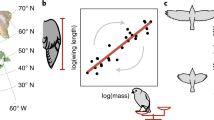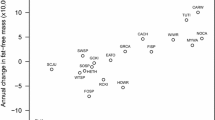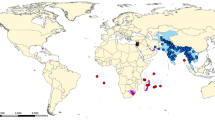Abstract
The capacity of non-native species to undergo rapid adaptive change provides opportunities to research contemporary evolution through natural experiments. This capacity is particularly true when considering ecogeographical rules, to which non-native species have been shown to conform within relatively short periods of time. Ecogeographical rules explain predictable spatial patterns of morphology, physiology, life history and behaviour. We tested whether Australian populations of non-native starling, Sturnus vulgaris, introduced to the country approximately 150 years ago, exhibited predicted environmental clines in body size, appendage size and heart size (Bergmann’s, Allen’s and Hesse’s rules, respectively). Adult starlings (n = 411) were collected from 28 localities from across eastern Australia from 2011 to 2012. Linear models were constructed to examine the relationships between morphology and local environment. Patterns of variation in body mass and bill surface area were consistent with Bergmann’s and Allen’s rules, respectively (small body size and larger bill size in warmer climates), with maximum summer temperature being a strongly weighted predictor of both variables. In the only intraspecific test of Hesse’s rule in birds to date, we found no evidence to support the idea that relative heart size will be larger in individuals which live in colder climates. Our study does provide evidence that maximum temperature is a strong driver of morphological adaptation for starlings in Australia. The changes in morphology presented here demonstrate the potential for avian species to make rapid adaptive changes in relation to a changing climate to ameliorate the effects of heat stress.



Similar content being viewed by others
References
Allen J (1877) The influence of physical conditions in the genesis of species. Radic Rev 1:108–140
Ashton K (2002) Patterns of within-species body size variation of birds: strong evidence for Bergmann’s rule. Glob Ecol Biogeogr 11:505–523
Ashton KG, Tracy MC, de Queiroz A (2000) Is Bergmann’s rule valid for mammals? Am Nat 156:390–415. doi:10.1086/303400
Baker AJ (1980) Morphometric differentiation in New Zealand populations of the house sparrow (Passer domesticus). Evolution 34:638–653
Balmford R (1978) Early introduction of birds to Victoria. Aust Bird Watch 7:237–248
Barton K (2013) MuMIn: multi-model inference. R package version 1.15.6. http://CRAN.R-project.org/package=MuMIn
Bergmann C (1847) Über die Verhältnisse der Wärmeökonomie der Thiere zu ihrer Grösse. Gött Stud 3:595–708
Blackburn T, Gaston K, Loder N (1999) Geographic gradients in body size: a clarification of Bergmann’s rule. Divers Distrib 5:165–174
Blem CR (1974) Geographic variation of thermal conductance in the house sparrow Passer domesticus. Comp Biochem Physiol Part A Physiol 47:101–108. doi:10.1016/0300-9629(74)90056-5
Burness G, Huard JR, Malcolm E, Tattersall GJ (2013) Post-hatch heat warms adult beaks: irreversible physiological plasticity in Japanese quail. Proc R Soc B Biol Sci. doi:10.1098/rspb.2013.1436
Burnham K, Anderson D (2002) Model selection and multimodel inference: a practical information-theoretic approach
Burnham KP, Anderson DR, Huyvaert KP (2011) AIC model selection and multimodel inference in behavioral ecology: some background, observations, and comparisons. Behav Ecol Sociobiol 65:23–35
Campbell-Tennant D, Gardner J, Kearney M, Symonds M (2015) Climate-related spatial and temporal variation in bill morphology over the past century in Australian parrots. J Biogeogr 42:1163–1175
Clavero M, Garcia-Berthou E (2005) Invasive species are a leading cause of animal extinctions. Trends Ecol Evol 20:110. doi:10.1016/j.tree.2005.01.003
Diamond JM (1984) “Normal” extinction of isolated populations. Chicago University Press, Chicago
East R, Pottinger R (1975) Starling (Sturnus vulgaris L.) predation on grass grub [Costelytra zealandica (White), Melolonthinae] populations in Canterbury. New Zeal J Agr Res 18:417–452
Fleischer RC, Johnston RF (1982) Natural selection on body size and proportions in house sparrows. Nature 298:747–749. doi:10.1038/298747a0
Freeman S, Jackson WM (1990) Univariate metrics are not adequate to measure avian body size. Auk 107:69–74
Gardner JL, Heinsohn R, Joseph L (2009) Shifting latitudinal clines in avian body size correlate with global warming in Australian passerines. Proc Biol Sci 276:3845–3852. doi:10.1098/rspb.2009.1011
Gardner JL, Peters A, Kearney MR et al (2011) Declining body size: a third universal response to warming? Trends Ecol Evol 26:285–291
Gaston KJ, Chown SL, Evans KL (2008) Ecogeographical rules: elements of a synthesis. J Biogeogr 35:483–500. doi:10.1111/j.1365-2699.2007.01772.x
Gilchrist G, Huey R, Serra L (2001) Rapid evolution of wing size clines in Drosophila subobscura. Genetica 112–113:273–286
Greenberg R, Danner RM (2012) The influence of the California marine layer on bill size in a generalist songbird. Evolution 66:3825–3835. doi:10.1111/j.1558-5646.2012.01726.x
Greenberg R, Danner R, Olsen B, Luther D (2012) High summer temperature explains bill size variation in salt marsh sparrows. Ecography 35:146–152. doi:10.1111/j.1600-0587.2011.07002.x
Hammond KA, Szewczak J, Król E (2001) Effects of altitude and temperature on organ phenotypic plasticity along an altitudinal gradient. J Exp Biol 204:1991–2000
Hawkins BA, Felizola Diniz-Filho JA (2004) “Latitude” and geographic patterns in species richness. Ecography 27:268–272. doi:10.1111/j.0906-7590.2004.03883.x
Hesse R, Allee WC, Schmidt KP (1937) Ecological animal geography: an authorized, rewritten edition based on Tiergeographie auf oekologischer Rundlage. Cornell University, Ithaca
Hijmans RJ (2015) Raster: geographic data analysis and modeling. R package version 2.5-2. http://CRAN.R-project.org/package=raster
Hijmans RJ, Cameron SE, Parra JL et al (2005) Very high resolution interpolated climate surfaces for global land areas. Int J Climatol 25:1965–1978. doi:10.1002/joc.1276
Jenkins CFH (1977) The Noah’s ark syndrome. Zoological Gardens Board, Western Australia
Johnston RF, Selander RK (1964) House sparrows: rapid evolution of races in North America. Science 144:548–550. doi:10.1126/science.144.3618.548
Johnston R, Selander R (1973) Evolution in the house sparrow. III. Variation in size and sexual dimorphism in Europe and North and South America. Am Nat 107:373–390
Konarzewski M, Diamond J (2014) Evolution of basal metabolic rate and organ masses in laboratory mice. Evolution 49:1239–1248
Laiolo P, Rolando A (2001) Ecogeographic correlates of morphometric variation in the red-billed chough Pyrrhocorax pyrhocorax and the alpine chough Pyrrhocorax graculus. Ibis Lond 1859 143:602–616
Lomolino MV, Sax DF, Riddle BR, Brown JH (2006) The island rule and a research agenda for studying ecogeographical patterns. J Biogeogr 33:1503–1510. doi:10.1111/j.1365-2699.2006.01593.x
Long JL (1981) Introduced birds of the world. Universe Books, New York
Lowe S, Browne M, Boudjelas S, Poorter M De (2000) One hundred of the world’s worst invasive species: a selection from the global invasive species database. Speacies survival commission, World Conservation Union, Auckland, New Zealand
Maldonado KE, Cavieres G, Veloso C et al (2009) Physiological responses in rufous-collared sparrows to thermal acclimation and seasonal acclimatization. J Comp Physiol B 179:335–343. doi:10.1007/s00360-008-0317-1
Meiri S, Dayan T (2003) On the validity of Bergmann’s rule. J Biogeogr 30:331–351
Millien V, Kathleen Lyons S, Olson L et al (2006) Ecotypic variation in the context of global climate change: revisiting the rules. Ecol Lett 9:853–869. doi:10.1111/j.1461-0248.2006.00928.x
Morton SR, Stafford Smith DM, Dickman CR et al (2011) A fresh framework for the ecology of arid Australia. J Arid Environ 75:313–329. doi:10.1016/j.jaridenv.2010.11.001
Müller J, Bässler C, Essbauer S et al (2014) Relative heart size in two rodent species increases with elevation: reviving Hesse’s rule. J Biogeogr 41:2211–2220. doi:10.1111/jbi.12365
Murphy E (1985) Bergmann’s rule, seasonality, and geographic variation in body size of house sparrows. Evolution 39:1327–1334
Nudds R, Oswald S (2007) An interspecific test of Allen’s rule: evolutionary implications for endothermic species. Evolution 61:2839–2848
Olson VA, Davies RG, Orme CDL et al (2009) Global biogeography and ecology of body size in birds. Ecol Lett 12:249–259. doi:10.1111/j.1461-0248.2009.01281.x
Packard G (1967) House sparrows: evolution of populations from the Great Plains and Colorado Rockies. Syst Biol 16:73–89
Peig J, Green AJ (2009) New perspectives for estimating body condition from mass/length data: the scaled mass index as an alternative method. Oikos 118:1883–1891. doi:10.1111/j.1600-0706.2009.17643.x
Peig J, Green AJ (2010) The paradigm of body condition: a critical reappraisal of current methods based on mass and length. Funct Ecol 24:1323–1332. doi:10.1111/j.1365-2435.2010.01751.x
Peters RH (1983) The ecological implications of body size. Cambridge University Press, New York
Phillips BL, Brown GP, Webb JK, Shine R (2006) Invasion and the evolution of speed in toads. Nature 439:803
Rensch B (1938) Some problems of geographical variation and species-formation. Proc Linn Soc Lond 150:275–285. doi:10.1111/j.1095-8312.1938.tb00182k.x
Rising JD, Somers KM (1989) The measurement of overall body size in birds. Auk 106:666–674
Rollins LA, Woolnough AP, Wilton AN et al (2009) Invasive species can not cover their tracks: using microsatellites to assist management of starling (Sturnus vulgaris) populations in Western Australia. Mol Ecol 18:1560–1573
Serrat MA (2013) Allen’s rule revisited: temperature influences bone elongation during a critical period of postnatal development. Anat Rec 296:1534–1545. doi:10.1002/ar.22763
Snow D (1954) Trends in geographical variation in Palearctic members of the genus Parus. Evolution 8:19–28
Symonds MRE, Tattersall GJ (2010) Geographical variation in bill size across bird species provides evidence for Allen’s rule. Am Nat 176:188–197
Tattersall GJ, Andrade DV, Abe AS (2009) Heat exchange from the toucan bill reveals a controllable vascular thermal radiator. Science 325:468–470. doi:10.1126/science.1175553
Thomas CD, Cameron A, Green RE et al (2004) Extinction risk from climate change. Nature 427:145–148
Tieleman BI, Williams JB, Buschur ME, Brown CR (2003) Phenotypic variation of larks along an aridity gradient: are desert birds more flexible? Ecology 84:1800–1815
VanderWerf E (2012) Ecogeographic patterns of morphological variation in elepaios (Chasiempis spp.): Bergmann’s, Allen’s, and Gloger’s rules in a microcosm. Ornithol Monogr 73:1–34
Ward S, Rayner JMV, Moller U et al (1999) Heat transfer from starling Sturnus vulgaris during flight. J Exp Biol 1602:1589–1602
Wiersma P, Munoz-Garcia A, Walker A, Williams JB (2007) Tropical birds have a slow pace of life. PNAS 104:9340–9345
Williams JB, Tieleman BI (2000) Flexibility in basal metabolic rate and evaporative water loss among Hoopoe Larks exposed to different temperatures. J Exp Biol 3159:3153–3159
Wolak ME, Fairbairn DJ, Paulsen YR (2012) Guidelines for estimating repeatability. Methods Ecol Evol 3:129–137
Yahav S, Straschnow A, Plavnik I, Hurwitz S (1997) Blood system response of chickens to changes in environmental temperature. Poultry Sci 76:627–633
Yom-Tov Y, Geffen E (2011) Recent spatial and temporal changes in body size of terrestrial vertebrates: probable causes and pitfalls. Biol Rev Camb Philos Soc 86:531–541. doi:10.1111/j.1469-185X.2010.00168.x
Acknowledgments
We thank Raymond Livermore, Margaret and Tim Bennett, Justin Dittmenn, and David Geering for helping with sample collection and many agriculturalists across Australia for letting investigators work on their land. We thank Jessica Moore for laboratory assistance, Mark Richardson for field assistance and Dale Nimmo for assistance with statistical analysis. Most importantly we acknowledge the starlings that were killed to conduct this research. The project was conducted under ethics approval A53-2011 and all applicable institutional and/or national guidelines for the care and use of animals were followed. P. C. and K. L. B. were supported by Australia Research Council funding (FT0991420 and FT140100131, respectively).
Author contribution statement
A. P. A. C., M. R. E. S., K. L. B., P. C. and C. D. H. S. conceived and designed the study. A. P. A. C. collected the data. A. P. A. C. and M. R. E. S. analysed the data. A. P. A. C., M. R. E. S. and K. L. B., wrote the manuscript; all authors provided editorial advice.
Author information
Authors and Affiliations
Corresponding author
Additional information
Communicated by Ola Olsson.
Electronic supplementary material
Below is the link to the electronic supplementary material.
Rights and permissions
About this article
Cite this article
Cardilini, A.P.A., Buchanan, K.L., Sherman, C.D.H. et al. Tests of ecogeographical relationships in a non-native species: what rules avian morphology?. Oecologia 181, 783–793 (2016). https://doi.org/10.1007/s00442-016-3590-9
Received:
Accepted:
Published:
Issue Date:
DOI: https://doi.org/10.1007/s00442-016-3590-9




